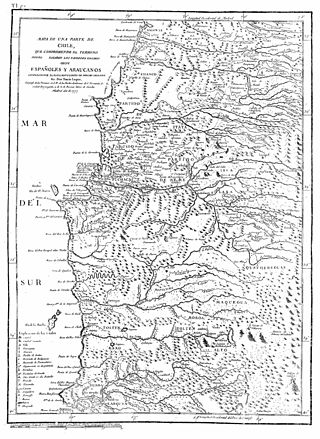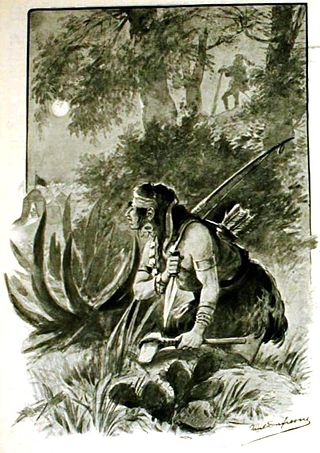Related Research Articles

The Arauco War was a long-running conflict between colonial Spaniards and the Mapuche people, mostly fought in the Araucanía region of Chile. The conflict began at first as a reaction to the Spanish conquerors attempting to establish cities and force Mapuches into servitude. It subsequently evolved over time into phases comprising drawn-out sieges, slave-hunting expeditions, pillaging raids, punitive expeditions, and renewed Spanish attempts to secure lost territories. Abduction of women and war rape was common on both sides.

Toqui is a title conferred by the Mapuche on those chosen as leaders during times of war. The toqui is chosen in an assembly or parliament (coyag) of the chieftains (loncos) of various clans (Rehues) or confederation of clans (Aillarehues), allied during the war at hand. The toqui commanded strict obedience of all the warriors and their loncos during the war, would organize them into units and appoint leaders over them. This command would continue until the toqui was killed, abdicated (Cayancaru), was deposed in another parliament, or upon completion of the war for which he was chosen.
Francisco López de Zúñiga y Meneses, 2nd Marquess of Baides and Count of Pedrosa was a Spanish soldier who served as Royal Governor of Chile from May 1639 to May 1646.
Tomás López Marín y González de Poveda, 1st Marquis of Cañada Hermosa was a Spanish colonial administrator who served as Royal Governor of Chile.
Illangulién, Quiromanite, Queupulien or Antiguenu, was the Mapuche toqui elected to replace Lemucaguin or Caupolicán the younger in 1559 following the Battle of Quiapo to his death in battle in the Battle of Angol in 1564.
Cadeguala or Cadiguala was a Mapuche toqui elected in 1585 following the death in battle of the previous toqui Nangoniel. Cadeguala was a noted warrior and the first Mapuche toqui known to have used cavalry successfully in battle. He was killed in a duel with the garrison commander of the Spanish fort at Purén in 1586.
Paineñamcu or Paynenancu or Alonso Diaz, was the Mapuche toqui from 1574 to 1584. Alonso Diaz was a mestizo Spanish soldier offended because the Governor of Chile did not promote him to the officer rank of alféres, who subsequently went over to the Mapuche in 1572. He took the Mapuche name of Paineñamcu and because of his military skills was elected toqui in 1574 following the death of Paillataru.
Nangoniel was the Mapuche Toqui in 1585, and son of the previous toqui Cayancaru. He was the first Toqui to use cavalry with the Mapuche army.
Cayancura, or Cayeucura, was a Mapuche leader native to the region of Marigüenu, chosen as toqui in 1584 to replace the captured Paineñamcu. His one great operation was an attempted siege of the fort at Arauco that failed, leading to his abdication of his office in favor of his son Nangoniel in 1585.
Vilumilla was the Mapuche Toqui elected in 1722 to lead the Mapuche Uprising of 1723 against the Spanish for their violation of the peace.

Lientur was the Mapuche toqui from 1618 to 1625. He was the successor to Loncothegua. Lientur with his vice toqui Levipillan was famed for his rapid malóns or raids. Because of his ability to slip back and forth over the Spanish border between its fortresses and patrols and raid deep into Spanish territory north of the Bio-Bio River without losses he was called the Wizard by the Spanish.
Lincoyan was the Mapuche toqui that succeeded Ainavillo in 1550 after the defeat at the Battle of Penco. He tried to stop Pedro de Valdivia from invading and establishing fortresses and cities in their lands between 1551 and 1553 at the beginning of the Arauco War with no success. In 1551 he attacked Valdivia on the banks of the Andalien, but the neighboring fort resisted his assaults. During part of that year and in 1552 he continued fighting against Valdivia along Cauten River. In 1553, he was replaced by Caupolicán, but he was given the command of a division. In this year he took part in the capture of the fortresses of Arauco and Tucapel. Soon after this battle he defeated a strong Spanish force that came to protect Imperial. He followed Caupolicán in all his victories and in all his battles until the death of that chief in 1558. Afterward he continued the war against the Spaniards until he was killed in the Battle of Cañete.
Turcupichun was the toqui of the Mapuche Aillarehues in the vicinity of Concepcion, Chile and the Bio-Bio River valley from 1557 to 1558. García Hurtado de Mendoza landed in early June 1557 on the island of La Quiriquina at the mouth of the bay of San Pedro. Soon afterward he sent out messengers to the local Aillarehues to come and submit to the Spanish. Turcupichun gathered them in a great coyag where he advocated resistance to the death and elected him as their toqui replacing the dead Lautaro.
Lemucaguin a native of Andalicán was the successor to Turcupichun as toqui of the Moluche Butalmapu north of the Biobío River in 1558. He organized a detachment of arquebusiers from weapons captured in the Battle of Marihueñu. He continued the war against García Hurtado de Mendoza after the executions of Caupolican and Turcupichun. Establishing pucaras at Quiapo and other locations to block Spanish access to the Arauco region. He was the first toqui to use firearms and artillery in the Battle of Quiapo However he was killed in this battle and was replaced by Illangulién. The later historian, Juan Ignacio Molina, calls the toqui that led at Quiapo Caupolicán the younger, son the executed toqui Caupolican
Guanoalca was the Mapuche toqui (leader) elected in 1586 following the death in battle of the previous toqui, Cadeguala, killed in a duel with the garrison commander of the Spanish fort at Purén in 1586. He returned to continue the siege and forced the Spanish to evacuate the fort, which he then destroyed.
Quintuguenu was the Mapuche toqui (leader) in the Arauco War elected in 1591 following the death of the old toqui Guanoalca. He was killed in battle the same year. Paillaeco was elected as his successor in 1592.
Lebian (Lebiantu) was toqui from 1769 to 1774, who led the Pehuenche against the Spanish Empire in Chile following the Mapuche Uprising of 1766 during the Arauco War.
Butapichón or Butapichún or Putapichon was the Mapuche toqui from 1625 to 1631, as successor to Lientur. After the death of Quepuantú in 1632 he became toqui once again from 1632 to 1634.
Paillamachu, was the Mapuche toqui from 1592 to 1603 in what is now Chile.
Ayllicuriche or Huaillacuriche was a Mapuche Toqui, holding that command from 1672 to his death in 1673. In 1672, Ayllicuriche and other Mapuche leaders attempted a revolt to resist the terms of an earlier treaty that put Spanish officials in authority over the Mapuche. However he did not get much support and the revolt was quickly crushed.
References
- ↑ Claudio Gay, "Historia fisica y politica de Chile", Tomo II, Cap. XXXII.
